#breton mythology
Text


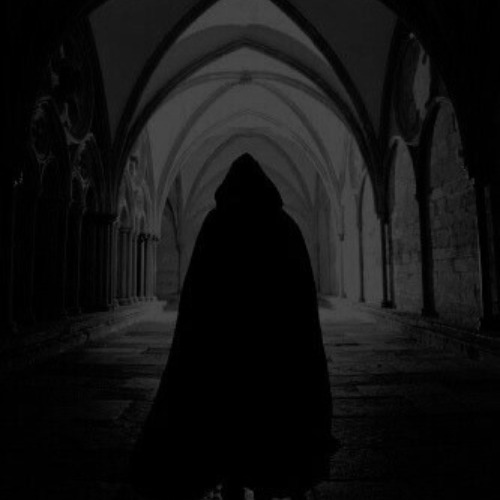
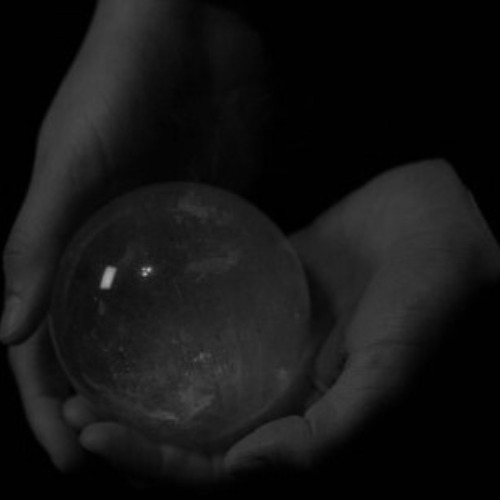
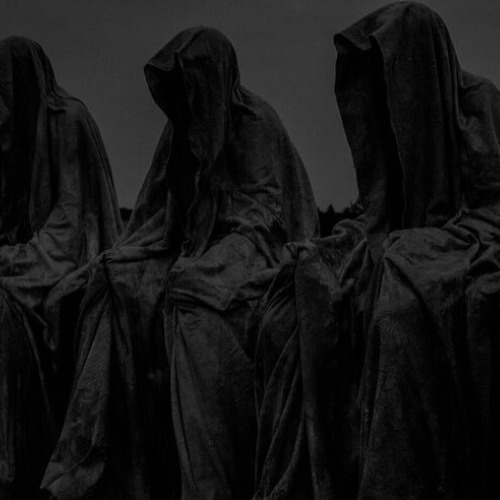
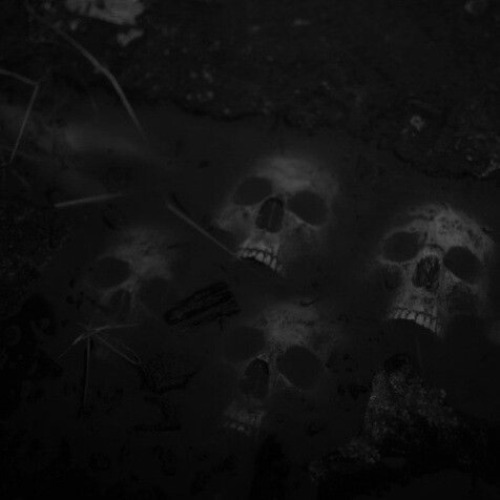
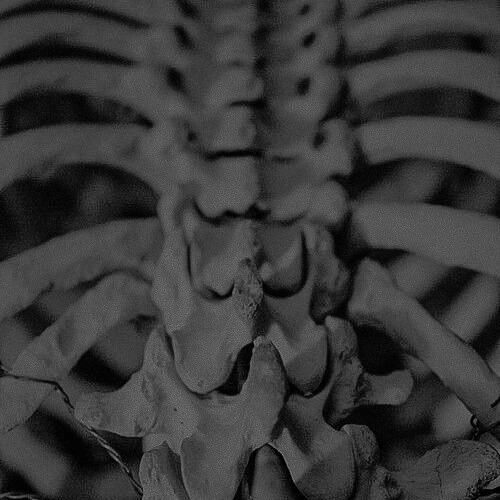

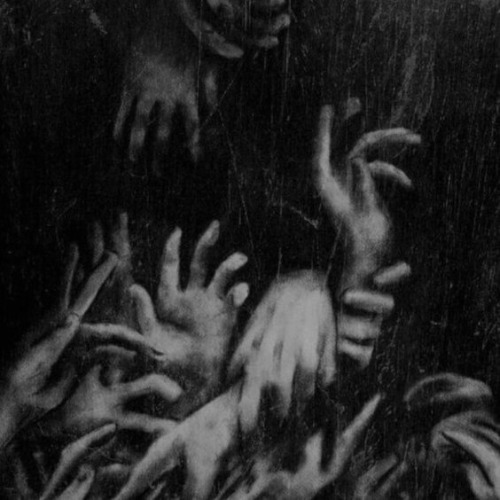
breton mythology: ankou
ankou is the servant of death. he appears as a man or skeleton wearing a black robe and a large hat that conceals his face, or, on occasion, simply as a shadow. he wields a scythe and is said to sit atop a cart for collecting the dead, or to drive a large, black coach pulled by four black horses and accompanied by two ghostly figures on foot. in some versions, ankou is depicted as the first dead person of the year, charged with collecting others' souls before he can go to the afterlife.
150 notes
·
View notes
Photo
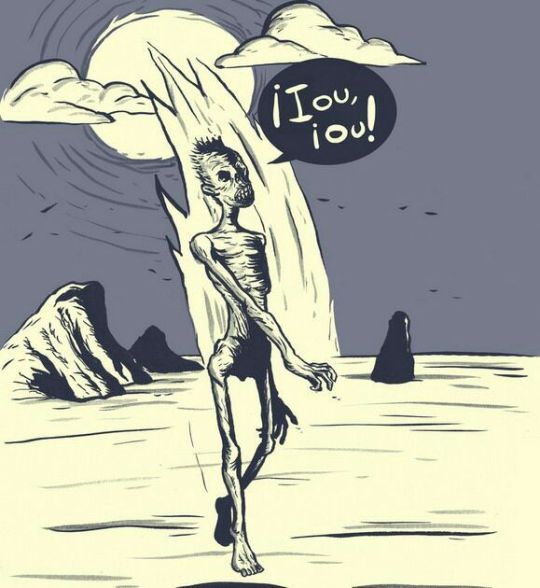
Yannig An Od [Celtic/Breton mythology]
Imagine you’re taking a stroll on the bank of a river. In the distance, you see an elderly man rowing a little boat. Suddenly, you hear a strange bird calling once, twice, and a third time. It sounds like ‘Iouhou!’ If you answered or yelled something back, the enigmatic man on the boat suddenly takes a giant leap and devours you.
This is the Yannig An Od – a mysterious creature from Breton folktales. There are a bunch of different names and retellings of the story: Yann-an-Ord, Iannic-ann-ôd, Yannig an Aod, etc. But the basics are always the same: the spirit resides near a riverbank or seashore and calls out three times, and kills those who answer or return its calls. ‘An od’ and its variations mean ‘of the shore’ while Iannic, Yann and Yannig are given names (often translated as ‘John’ or ‘Johnny’).
Collectively, these similar folk monsters are often called ‘Yannig’ and they are sometimes likened to fairies or sirens.
The spirit was said to rule over the Odet River in Breton. It was the undead ghost of a drowned man and dwelt on the riverbanks and let out its strange cry three times in succession, which was somewhat similar to that of an owl, and to leap at and devour anyone who was foolish enough to answer or mock the cries. Eventually, it was defeated by the wit of a local folk hero, Konan Ruz.
As legend has it, Konan was on an errand for flour to bake bread when he heard the three owl-like hoots. Not knowing their origin but annoyed at the noise, he hooted back in a mocking tone. Suddenly, Yannig An Od appeared and threw the man on his side. Konan however was a physically strong lad and managed to overpower his assailant by hitting the creature’s feet and causing it to fall on the ground. Konan put his knee on the being’s throat and held it down. The creature, now struggling to breathe, begged Konan to release it since apparently he came out of the water too early (before midnight). The man agreed to release his captive but only on the condition that the spirit would tell him some secrets about the world it came from: not the afterlife, but the place between the plane of the dead and the world of the living. This did not please the spirit, who warned that this information was not meant for the ears of a baptized man.
Yannig An Od told Konan that the ocean is a living being who sent wrinkles/waves across its skin every day, to counteract aging. At sunset, the sun descends into the ocean, warming its heart and waking it. The sea then makes a loud noise with its bowels, and in that hour the morgans and other mythical creatures from the depths sound the bells of their underwater towers. At that hour, Yannig An Od rises from between the rocks of the riverside, as these rocks contain the souls of the drowned.
Konan remembered that fishermen sometimes see thousands of human corpses in the ocean and asked Yannig what this means. The creature replied that these were the spirits of drowned people who remain in the ocean. When they reach a certain age, drowned corpses can freely move around in the ocean and wander beneath the waves in great numbers. Yannig also told his captor about the green sun, which is the source of the unnatural power that he and the drowned ones have. This sun can be seen underwater at night and has a connection with the afterlife, though the details are not entirely clear to me. When daytime comes, the drowned dead retake their places among the rocks of the seafloor and wait until the green sun rises once again.
Konan did not realize the creature’s trickery until it was too late: Yannig An Od was buying time with his stories until the clock struck midnight and the green sun arose under the sea. Now back at full power, he fought and killed his enemy. Konan died but managed to scare the spirit and to this day, the creature is too afraid to let out its cry near Konan’s side of the river it inhabits.
That being said though, Yannig An Od is still a dangerous entity and should you hear its cry, take care not to mock it, for this will entice the ghost to attack you. It is said that if you encounter this spirit, you have to remove your shoes and run barefoot across the beach or riverbank with your shoes in your hands.
In addition, Yannig An Od may also come to peoples’ houses. He will knock on the door and ask for a small piece of burning or smouldering wood from the fireplace. You should never give in to this strange request, though it isn’t entirely clear to me what will happen if you do or what the ghost plans to use the wood for.
Sources:
Garnett, L. M. J., 1896, New Folklore Researches: Folk-Prose. Modern Revolution. Historical Introductions. University of Michigan.
Monaghan, P., 2004, The Encyclopedia of Celtic Mythology and Folklore, Facts on File, 512 pp.
(image source: Cherryheart on Wattpad)
115 notes
·
View notes
Text

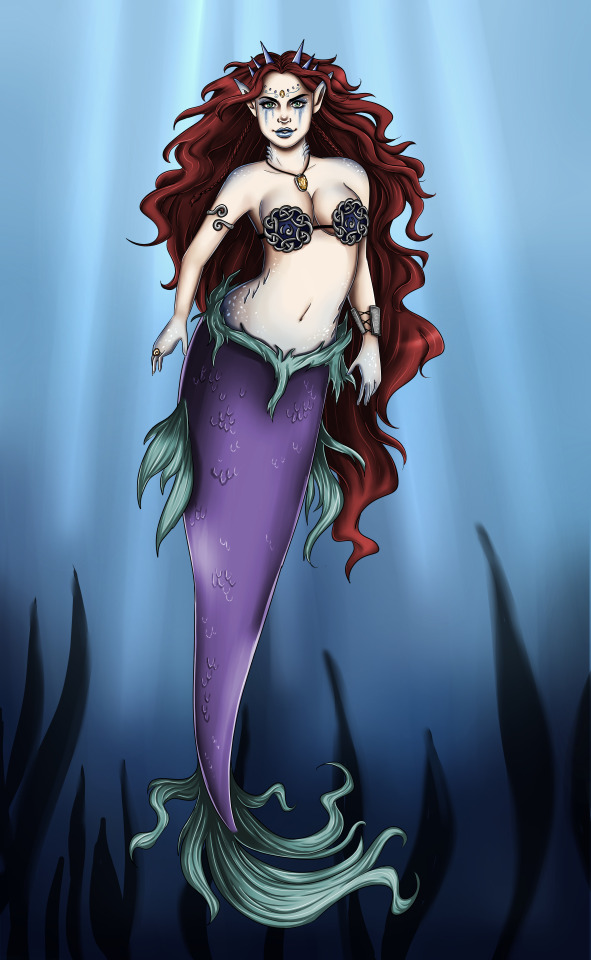
Kroashent Character Spotlight: Ahes Dahut, Queen of Ys
For August/September, I'm taking on a little side project, cleaning up and finishing some of the placeholder characters on the Kroashent WorldAnvil. Oftentimes, inspiration strikes suddenly, leaving me with a lot of unfinished concepts that don't quite fit cleanly into the mix. I'll be returning to answering Q+As soon (questions are always open and welcome) and writing the next chapters of the book. In the meantime, working on a lot of commission work, so this is something of a side project when the tablet is charging.
------------
Val's Notes: Major character today, the Queen of the Marie-Morgane, Ahes Dahut. I typically constrain my mermaids to "Mermay", but it seems like a good time to actually address her.
Special thanks to the amazing Veika for the wonderful character art!
(Check out her gallery here: https://www.deviantart.com/veika)
#kroashent#Character Biography#Fantasy#fantasy character#world anvil#mermaid#Marie-Morgane#Ahes#Dahut#Ahes Dahut#Breton Mythology#pansexual#lgbt
2 notes
·
View notes
Text
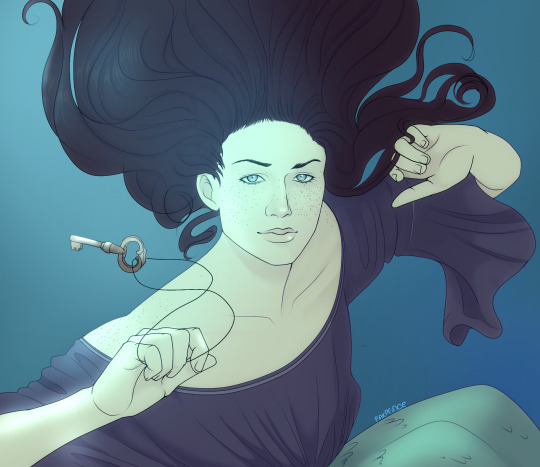
Dahut-Ahes of Brittany :)
#my art#artists on tumblr#celtic mythology#dahut#ahes#legend of kys#breton mythology#french folklore#breton folklore
3 notes
·
View notes
Text
does anyone have any good english-language (or french-language, but english language is preferred) book recs on manx mythology/folklore and/or breton mythology/folklore?
3 notes
·
View notes
Text

Lancelot Du Lac sketch
#lancelot#lancelot du lac#lancelot of the lake#guinevere#queen guinevere#camelot#knights of the round table#arthuriana#arthurian mythology#lancillotto#ginevra#ciclo bretone#arthurian stuff#arthurian legend#my art#lancelot x guinevere
47 notes
·
View notes
Text
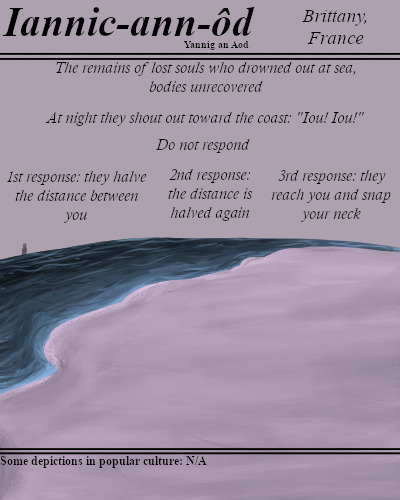
Take care and be aware, it takes only three return shouts for this spirit to reach you if it believes you are mocking them.
#BriefBestiary#bestiary#digital art#fantasy#folklore#legend#myth#mythology#iannic-ann-ôd#yannig an aod#ghost#spirit#undead#Iou! Iou!#lost soul#monster#breton folklore#breton legend
34 notes
·
View notes
Text
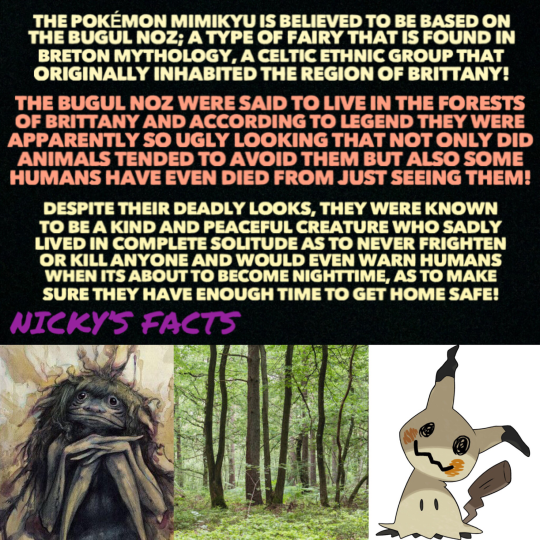
Poor Bugul Noz, they live forever alone in sadness just to keep us safe.🌲🌳🌲
😭
#history#bugul noz#mimikyu#mythology#celtic#pokemon#breton#ancient history#fairy#celtic mythology#ugly#french history#brittany#gaul#mythical creatures#celtic culture#fairycore#france#myth#alola#game freak#nintendo#celtic history#ancient#nickys facts
96 notes
·
View notes
Photo
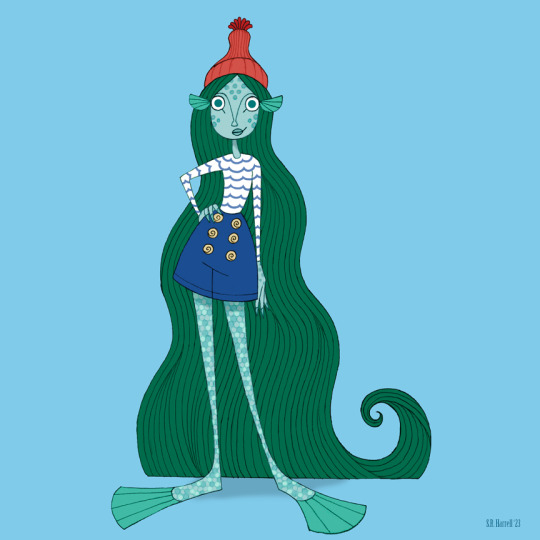
“Morgan” by S.R. Harrell, 2023
2 notes
·
View notes
Text
UNBLENDING CELTIC POLYTHEISTIC PRACTICES
Celtic Umbrella
This lesson is largely focusing on the insular Celtic nations & Brittany (Ireland/Eire, Scotland/Alba, Wales/Cymru, Cornwall/Kernow, Isle of Man/Mannin, & Brittany/Breizh) - traditionally regarded as 6 out of the 7 Celtic nations. Galicia/Galizia is the 7th, but because of a mix of the below + my own lack of knowledge, I won't be covering them.
The vast swath of Continental Celtic cultures are a different but equally complex topic thanks to extinction, revival, varying archaeological artefacts and the work of modern practioners to piece unknown parts back together.
This will serve as a quick 'n' dirty guide to the insular Celtic nations, Celtic as a label, blood percentages and ancestry, the whats and whys of "Celtic soup", and how to unblend practice.
The insular Celtic groups are split into two language groups: Brythonic languages and Gaelic languages.
Brythonic languages are Cymraeg/Welsh, Kernewek/Cornish, & Breton
Gaelic languages are Gàidhlig/Scottish, Gaeilge/Irish, & Gaelg/Manx.
The language split leads to certain folkloric and religious figures & elements being more common within the language group than without. All of these nations had historic cultural exchange and trade routes via the Celtic sea (and beyond). Despite this, it is still important to respect each as a home to distinct mythologies.
Pros/Cons of a broad Celtic umbrella
Pros
- Used within celtic nations to build solidarity
- Relates to a set of cultures that have historic cultural exchange & broad shared experiences
- A historic group category
- Celtic nations’ culture is often protected under broad legislation that explicitly highlights its ‘Celtic-ness’.
Cons
- Can be used reductively (in academia & layman uses)
- Often gives in to the dual threat of romanticisation/fetishisation & erasure
- Conflates a lot of disparate practices under one banner
- Can lead to centring ‘celtic american’ experiences.
- Celtic as a broad ancestral category (along with associated symbols) has also been co-opted by white supremacist organisations.
In this I’m using ‘Celtic’ as a broad umbrella for the multiple pantheons! This isn’t ideal for specifics, but it is the fastest way to refer to the various pantheons of deities that’ll be referenced within this Q&A (& something that I use as a self identifier alongside Cornish).
What about blood % or ancestry?
A blood percentage or claimed Celtic ancestry is NOT a requirement to be a follower of any of the Celtic pantheons. The assumption that it does or is needed to disclose can feed easily into white supremacist narratives and rhetoric, along side the insidious implications that a white person in the USA with (perceived or real) Celtic ancestry is 'more celtic' than a person of colour living in a Celtic region (along with other romanticised notions of homogenously white cultures).
Along side this, a blood percentage or distant ancestry does not impart the culture and values of the Celtic region or it's recorded pagan practices by itself. Folk traditions are often passed down within families, but blood percentage is not a primary factor within this.
Connecting with ancestry is fine, good, and can be a fulfilling experience. It stops being beneficial when it leads to speaking over people with lived experiences & centres the USA-based published and authors - which can lead to blending/souping for reasons further on.
What is 'soup'?
Celtic soup is a semi-playful term coined by several polytheists (primarily aigeannagusacair on wordpress) to describe the phenomenon of conflating & combining all the separate pantheons and practices from the (mainly) insular Celtic nations into one singular practice - removing a lot of the regionalised folklore, associated mythos, & varying nuances of the nations that make up the soup.
Why does it happen?
The quick version of this is book trends and publishing meeting romanticisation and exotification of Celtic cultures (especially when mixed with pre-lapsarian views of the Nations). It's miles easier to sell a very generally titled book with a lot of Ireland and a little of everywhere else than it is to write, source and publish a separate book on each.
This is where centering American publishers and authors becomes an issue - the popular trend of USA-based pagan publications to conflate all celtic nations makes it hard to find information on, for example, Mannin practices because of the USA’s tendency to dominate media. Think of Llewellyn’s “Celtic Wisdom” series of books.
It has also been furthered by 'quick research guides'/TL;DR style posts based on the above (which have gained particular momentum on tumblr).
The things that have hindered the process in unblending/"de souping" is the difficulty in preserving independently published pamphlets/books from various nations (often more regionalised and immediately local than large, sweeping books generalising multiple practices) along with the difficulty of accessing historic resources via academic gatekeeping.
All of this has lead to a lack of awareness of the fact there is no, one, singular Celtic religion, practice or pantheon.
Why should I de-soup or unblend my practice?
Respecting the deities
It is, by and large, considered the bare minimum to understand and research a deity's origin and roots. The conflation of all insular Celtic deities under one singular unified pantheon can divorce them from their original cultures and contexts - the direct opposite to understanding and researching.
Folklore and myth surrounding various Celtic deities can be highly regionalised both in grounded reality and geomythically - these aren't interchangeable locations and are often highly symbolic within each nation.
Brú na Bóinne, an ancient burial mound in Ireland, as an entrance to the otherworld of the Tuatha Dé Danann.
Carn Kenidjack & the Gump as a central site of Cornish folk entities feasts and parties, including Christianised elements of Bucca’s mythology.
The Mabinogion includes specific locations in Wales as well as broad Kingdoms - it’s implied that Annwn is somewhere within the historic kingdom of Dyfed, & two otherworldly feasts take place in Harlech & Ynys Gwales.
Conflating all celtic pantheons under one banner often leads to the prioritisation of the Irish pantheon, meaning all of the less ‘popular’ or recorded deities are sidelined and often left unresearched (which can lead to sources & resources falling into obscurity and becoming difficult to access).
Respecting the deities
Deities, spirits, entities, myth & folklore are often culturally significant both historically and to modern day people (just average folks along with practitoners/pagans/polytheists and organisations) located in the various Nations
A primary example is the initiatory Bardic orders of Wales and Cornwall.
Desouping/Unblending makes folklorist's lives easier as well as casual research less difficult to parse. The general books are a helpful jumping off point but when they constitute the bulk of writing on various Celtic polytheisms, they become a hinderance and a harm in the research process.
A lot of mythology outside of deities & polytheisms is also a victim of ‘souping' and is equally as culturally significant - Arthurian mythology is a feature of both Welsh and Cornish culture but is often applied liberally as an English mythology & and English figure.
Celtic nations being blended into one homogenous group is an easy way to erase cultural differences and remove agency from the people living in celtic nations. Cornwall is already considered by a large majority of people to be just an English county, and many areas of Wales are being renamed in English for the ease of English tourists.
How can I de-soup?
Chase down your sources' sources, and look for even more sources
Check your sources critically. Do they conflate all pantheons as one? Do they apply a collective label (the celts/celts/celt/celtic people) to modern day Celtic nations? How far back in history do they claim to reach?
Research the author, are they dubious in more ways than one? Have they written blog articles you can access to understand more of their viewpoints? Where are they located?
Find the people the author cites within their work - it can be time consuming but incredibly rewarding and can also give a good hint at the author's biases and research depth. You may even find useful further reading!
Find primary sources (or as close too), or translations of the originating folklore, e.g The Mabinogion. Going to the source of a pantheon’s mythos and folklore can be helpful in discerning where soup begins in more recent books as well as gaining insight into deities' actions and relationships.
Ask lots of questions
Question every source! Question every person telling you things that don't define what pantheon or region they’re talking about! Write all your questions down and search for answers! Talk to other polytheists that follow specific Celtic pantheons, find where your practices naturally overlap and where they have been forced into one practice by authors!
Be honest with yourself
There’s no foul in spreading your worship over several pantheons that fall under the celtic umbrella! A lot of polytheists worship multiple pantheons! But be aware of the potential for soup, and make sure you’re not exclusively reading and working from/with sources that conflate all practices as one.
If you approach any Celtic polytheistic path with the attitude of blood percentage or 'ancestral right', stop and think critically about why you want to follow a Celtic polytheistic path. Is it because it's the most obviously 'open' path to follow? Is it a desire to experience what other folks experience? Being critical, turning inward, and really looking at yourself is important.
Originally posted in the Raven's Keep discord server
#celtic polytheism#celtic paganism#celtic soup#celtic#celtic reconstructionism#celtic revivalism#celtic polytheist#celtic pagan#celtic religion
441 notes
·
View notes
Text


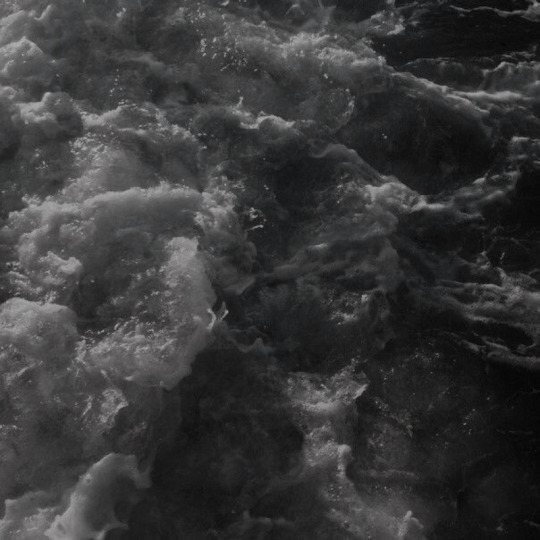






welsh & breton mythology: morgans
morgen are water spirits that drown men. they lured sailors with their hypnotic voices and sat in the water to comb their hair seductively. they were believed to live near coasts, at cave entrances and at the mouths of rivers, with some held to still inhabit a cave near crozon. the morgans, who were well-versed in evil spells, would drag young men underwater and the men would never be seen again. in some versions, however, morgans carried kidnapped sailors to underwater palaces of mother-of-pearl and crystal, and married them. the morgens, eternally young, are also blamed for heavy flooding that destroys crops or villages.
159 notes
·
View notes
Photo
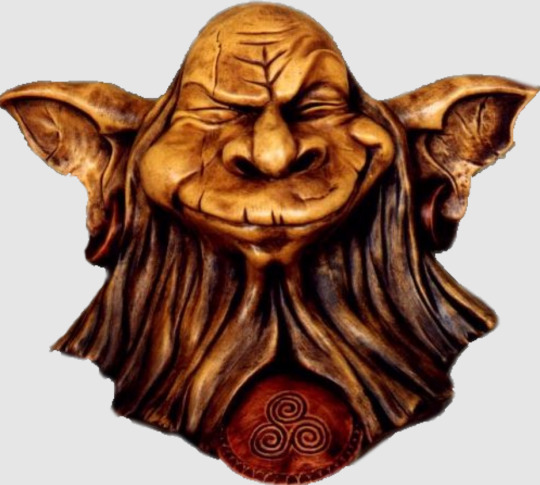
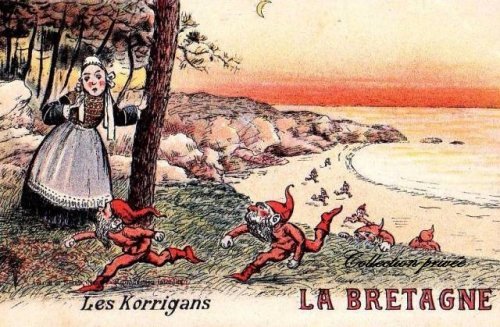
The Korrigan [Breton myths/poems]
A Korrigan is a small, fairy-like creature from Breton mythology. In modern times, they are usually depicted as tiny dwarves with a red cap, or as small human-like creatures with large ears or goblin-like characteristics. They are not inherently malicious but can be very dangerous if angered.
The old Breton poem “Aotrou Nann hag Korrigan” or “Lord Nann and the Korrigan” is probably the most famous depiction of these creatures, and depicts them as magical fairies with the ability to cast powerful curses on people. It tells of lord Nann, a noble whose wife gave birth to twins. Nann sets out to hunt, so he can provide a meal for his family, when he finds and disturbs a fairy creature. This being, a Korrigan, is disgruntled and demands that Nann marries her. If he refuses, he will die in three days.
But Nann is loyal to his wife and refuses her offer. He leaves and resumes his hunt. At last, he returns home to his family, having caught plenty of game. Nann believes the Korrigan is bluffing, surely his love for his wife and children will overcome whatever foul magic the fairy can cast upon him.
Alas, he proved unable to overcome Korrigan’s curse. As the creature predicted, Nann fell ill and succumbed to a strange disease three days later. Not long after, his wife fell on her knees and died, presumably from sadness. She was buried next to her husband. On their graves, two oaks grew and eventually, a couple of white doves was seen on their branches. The two doves spread out their wings and flew to heaven.
Sources:
Keightley, T., 1828, The Fairy Mythology: Illustrative of the romance and superstition of various countries. You can read the book, including “Lord Nann and the Korrigan” here along with some neat notes and remarks.
(image source 1: Wikipedia user “le Korrigan”)
(image source 2: post card from 1899, artist unknown, image from monsite.woopic.com)
69 notes
·
View notes
Note
hello,
this may sound like a silly question, but is it possible for someone who is not Irish, scottish, or British to be contacted by the Fae?
thank you!
Hello there.
This isn't a silly question, but it's one I will have to expound on a bit, as opposed to just giving a yes or no answer. I'll also preface this by saying that my personal beliefs will likely be contentious to some, and I encourage readers to take what they find useful and leave the rest if it conflicts with their own paradigm. Most of this comes from a mixture of personal gnosis and theory, and I am not attempting to assert authority on the subject or claim academic accuracy, so please keep that in mind.
To put it very simply, I believe that the Fae are present in every region of the world, and I have highly syncretic beliefs about the nature of the Fae and other spirits in general. For me, the folkloric specifics come down to cultural lenses and the ways that long-term worship and perception shape the expectations and manifestations of the Gloaming Folk. So, no, I don't think one has to be Gaelic or Brythonic in order to cultivate a relationship with the Fae.
For instance, when looking at the Faerie Faith, many people think primarily—if not only—of the insular Celts. The Fair Folk of the English; the Aos Sidhe of the Irish; the Daoine Sìth of the Scottish; the Sheeaghan of the Manx; the Twlwyth Teg of the Welsh; the Spyrysyon of the Cornish; and the Korrigan of the Breton. But in the larger context of Germanic and Scandinavian folklore, there is copious evidence of entities that are undeniably similar to the Fae as they are understood in the Insular Celtic Isles. In fact, the Germanic word Elf is so closely aligned with the term Faery that many people don't even realize or think about the fact that they derive from different cultures. That being said, the Germanic/Scandinavian "lens" of Faerie Lore is probably the other best known by the wider public.
Likewise, there are multiple beings that show up in Slavic mythology and folklore—such as the Vila, the Rusalke, or the Vodyanoy—which are pretty readily accepted as Faeries. I don't know of an overarching term that would necessarily be equivalent, but the folkloric link is still there.
Now, moving into a more controversial aspect of my beliefs, I also happen to think of Angels, Demons, and Djinn in terms of Gloaming Spirits. While I readily admit that millenia of regionally specific belief and veneration form unique "identies" that Spirits of a given culture may align more closely with, I believe that they are all part of one larger "family" of beings who have been interacting with humanity for many thousands of years. I realize that this will likely be considered an egregious oversimplication for some, or possibly even an erasure of the individuality these cultures possess; but for me, the things that make a tradition sacred and unique are not invalidated or snuffed out by by the fact that other cultures may find recognition in them. So, while I do think beings like Angels, Demons, and Djinn are inexorably interrelated, I also fully accept that they are unique and culturally specific. And frankly, I find it hard to believe that others who have engaged in intensive personal gnosis haven't come across similar threads of paradoxical interconnection.
Beyond these, though, I've also pinpointed other entities over the years that I think represent reasonable approximations of the Fae. These include things like:
The Peris of Persian Mythology (Beautiful aerial spirits sometimes known to work with humans called Peri-Kahn, who gained skills and abilities from the relationship. They are generally described as humanoid figures with beautiful wings, who are known for their michevious behavior, though at least one work references them as divine beings denied entry into paradise until such a times as they have atoned—a folkloric motif some will recognize in connection to certain folk-beliefs regarding the Angels and the Fae.)
The Yakshas of Hinduism, Buddhism, and Jainism (Spirits of nature often connected with water, fertility, plants, treasures, and the wilderness. While some are considered benign or benevolent, others are considered more mischevious or sinister, though most are considered capricious. Sometimes associated with ecological forces, and at other times, with the spirits of the dead. )
The Yōkai of Shintō (A diverse array of spirits—often explicitly equivacated with fairies, demons, and/or sprites—known to interact with humans in both benevolent and malevolent capacities. While many of these spirits are quite singular in their uniqueness, others are more recognizable within a broader archetypal folkloric context—such as the Zashiki-warashi, which are described as diminutive domestic sprites known for both their ability to bestow good fortune, and their tendency to perform mischevious pranks.)
The Korpokkur of Ainu Mythology (A race of little folk, associated with the Butterbur plant, who were said to leave gifts under cover of night—as they did not like being seen. They were believed to be the original inhabitants of Japan before the Ainu—which also echoes aspects of Celtic Faerie Lore.)
The Aziza of Dahomean Mythology (A race of supernatural little folk who are said to live in the Wilds—often beneath Anthills or within silk-cotton trees— and use their magic to help humans, as well as providing people with practical knowledge and spiritual wisdom.)
The Yumboes of Wolof Mythology (Spirits of the dead described as little folk with pearly white skin and silver hair who lived beneath hills and come out to dance beneath the Moonlight. They are known to hold great feasts, which humans are sometimes invited to.)
The Hellenic Nymphs, Sirens, and Kobaloi (As many know, Nymphs are animistic spirits of nature, considered beautiful, and known to interact with humans. Likewise, most will have heard of Sirens as beautiful, seductive, and dangerous spirits of the water who are known to entice and drown men. The Kobaloi, in turn, are described as a mischievous race of small goblin-like folk who are fond of playing tricks on human kind.)
The Basque Iratxoak, Laminak, and Mairuak (An Iraxto is a type of domestic Imp or Goblin known to help with human labors in the night, if properly propitiated. A Lamina, on the other hand, is a Water Maiden described similarly to Sirens or Nereids. They are generally understood to have webbed duck feet and long beautiful hair, which they are fond of combing by the waterside. They are known for both their tendency to offer aid to those who show them respect and propitiation, and their tendency to seduce and ensnare men. Some traditions speak of male giants called Mairuak, who are closely associated with Laminak, and are linked by some with the construction of megalithic structures.)
The Duende of Iberian mythology (A term quite similar to 'Faery' in its usage, which encompasses a diverse array of spiritual entities who are generally said to appear as humanoid, though frequently capable of shapeshifting. They are often associated with nature and are known for their involvement with humans—be it helpful, romantic, michevious, or vicious. They include goblin-esque folk known as Trasgu, Water Maidens known as Xana or Anjana, and supernatural beings called Mouros who take refuge beneath the earth and rarely emerge near sites like barrows. The most common conception of a Duende, however, describes them as a mischevious sort of domestic imp or goblin known for their dealings with the human world. )
The Aztec Chaneque (A sprite-like race of little folk who are associated with Elemental forces and are often conceived as guardians of nature. These beings were once propotiated by the Nàhuatl peoples in exchange for protection from blight, intruders, and evil forces. However, they could also inflict harm, and they were known to sometimes kidnap humans and take them to their home in the Underworld of of Mictlàn to be seduced. On an interesting sidenote, one folk-method of protecting against them when traveling in the forest was for a person to turn their clothing inside out—a charm many will recognize from Celtic Faerie Folklore.)
The Mayan Aluxo'ob (Spirits recognized in the mythological traditions of certain Maya peoples, who are generally associated with particular features of nature. They are described as small and humanoid, and they usually remain invisible, though they can assume physical form for the sake of interacting with humans. Sometimes, wandering Aluxo'ob are said to ask for offerings from farmers or travelers and may respond with wrath if refused. If its conditions are respectfully met, however, it is said that an Alux will provide protection, luck, and aid. In fact, some traditions hold that a farmer can erect a specialized form of Spirit House in order to welcome in an Alux that will aid them for a contracted period of time with tending crops, summoning favorable weather, and guarding property. What's more, there exist naming taboos that reflect themes of Celtic Faerie Lore.)
The Guarani Pombero (A spirit particularly important in Paraguay, though it appears in multiple mythological traditions from the surrounding area. The Pombero is generally conceived as a small hairy man who lives in forested areas and abandoned sites, and is known to cause mischief for humans. It is said that the Pombero can become invisible, change shape, and perfectly mimick the sounds of the wild. Usually, he is considered harmless, if mischevious—known for antics like food theft, the loosing of cattle, and the scattering of household objects. Though, he is also known also known to occasionally abduct and/or impregnate women, resulting in the births of hairy children. The Pombero is capable of being appeased, however, through offerings such as cigars, liquor, and honey. It is even said that, if these propitiations are observed consistently for long enough, the Pombero will take a liking to a person or persons and provide protection for their home and posessions, as well as leaving gifts of their own in return.)
The Tupi-Guarani Curupira (A spirit described in the folklore of Paraguay, Amazonia, Brasil, and Argentina as a little man with bright red hair and feet turned backwards, which it uses to obfuscate the trajectory of its footprints. They are said to live in the wild, and will prey on hunters who take more than they need, or who harm animals while they care for their Offspring. They are also said to ocassionally abduct and/or impregnate women, resulting in strange or unexplained births.)
The Iroquois Jogah (A race of magical little folk spoken of in Iroquois lore. They are said to be largely invisible, and an array of phenomena are associated with them, such as mysterious drumming noises, rings of bare earth, disembodied lights, and "bowls" found in stones. Offerings such as tobacco and fingernail parings could be left within these stone bowls, as propitiation to the Jogah. They are fond of mischief and games, though they can also be dangerous if disrespected. It is said, for example, that they will cause illness in homes constructed upon sites that they favor. The Jogah are also known for the variety of sub-groups into which they can be divided, generally associated with particular aspects or features of the natural world.)
& the Māori Patupaiarehe (Beings described in Māori mythology as a pale folk with red or golden hair. They are said to live in the mountains, hills, and deep forests in communities unseen by human eyes. They are known to influence the mist and clouds, to play music sweeter than that of any human hand, and were said to sometimes act with hostility towards humans who encroach or intrude upon their land. Despite this, however, most traditions state that Māori are able to converse with them at times.)
These are only a selection of traditional beliefs, though there are many more I won't attempt to list, and who knows how many more I've never heard. These are merely ones that have particularly caught my notice over time, and which seemed worth mentioning here. However, I am far from an anthropological expert, and I encourage others to ammend, contextualize, and add onto this information as they see fit—especially if they come from a culture I reference here. My goal is not to imply that all of these traditions are somehow directly connected to the Anglo-Celtic traditions, or that Anglo-Celtic mythology should be the cornerstone by which all folklore is considered; it's just the cultural background I have the most personal connection to/understanding of, and so I aim to speak mainly from a place of my own experience (though, I am actually half Paraguayan as well.)
So, in conclusion, while I do think that one's own cultural and regional context generally plays an important role in how one is likely to encounter the Gloaming Folk, I believe that people from virtually every culture have the capacity for working with them. I think that, when attempting to approach the Fae, it's a good idea for one to come at it from the perspective of their own heritage and regional lore, but at the same time, one can't always help the way spirits end up cultivating relationships with them (and, honestly, I think it is better for one to wait for the Fae to approach them whenever possible.)
#fae#fair folk#gloaming folk#gloaming#otherworld#faerie folk#faerie faith#good neighbors#pagan syncretism#syncretism#faerie lore#faerie folklore#anonymous#ask
201 notes
·
View notes
Text
The Bastardised Interpretations Of Daemons (And Other Spirits) Within The Dictionnaire Infernal

+. GIF Credit .+
•──────⋆༺🕸༻⋆──────•
So I got the idea for this post from my best friend @sortiarus-de--naturas--daemonum, and we both agreed that this was something that needed addressing; Especially in regards to Daemonolatry.
The Dictionnaire Infernal is one of the most widely known grimoires on demonology and all things occult. But what a lot of practitioners might not know is that it's actually quite a problematic resource for Daemonolatry and occult practices, and for several reasons. In fact, I personally don't think it's a reputable source in general, and this post is going to be detailing exactly why that is.
So without further ado, here's why the Dictionnaire Infernal might not be the greatest resource for Daemonolatrists, and why it's much more problematic than you think!
Full post under the cut. ↓
•──────⋆༺🕸༻⋆──────•
So, why is the Dictionnaire Infernal a bad resource for Daemonolatry and daemons in general? Well...
For starters, the book was written by someone who had very, very problematic views on other religions and belief systems... As in, racism, xenophobia, and religiophobia kind of problematic.
On top of that, Jacques Collin De Plancy (the author) had converted to Catholicism by the time he had started writing the Dictionnaire Infernal. So at this point, he was already going to have a biased interpretation of the Daemonic Divine, as he was interpreting them through a Christian-tainted lens; That is, in comparison to someone who seeks to learn about and venerate them. As a result, the entries on the daemons within his book were evidently written to play into the vilifying and denigration of daemons in general.
And to add insult to injury, a later edition was published with added illustrations, likely commissioned by De Plancy and drawn by Louis Le Breton, showcasing bastardised interpretations of daemons and demonised deities, interpreting them to look as monstrous and hideous as possible.
All around, it seems that both the spirits' entries and their illustrations were made with the main intent to mock and degrade them, as well as to portray them as being mere dirt beneath the feet of the Christian God. Obviously, a book portraying daemons in such a way is not going to be very helpful to a Daemonolatrist. If one wants to honour and work with daemons, what use is such a book that primarily mocks their very existence going to be?
Don't get me wrong; I think it's okay to go to the Dictionnaire Infernal for research, but only with the foreknowledge and understanding that the lore and mythology of the daemons and other spirits listed therein runs much deeper than the mere entries within the book, and that you shouldn't rely on it as your sole source of information on the Daemonic Divine.
But aside from these glaring issues, the Dictionnaire Infernal is just iniquitous and amoral in general; Which is no surprise, given that it was written in the 19th century and people back then held some very problematic beliefs... But that doesn't make any of it okay.
So, what other issues lie within the pages of the Dictionnaire Infernal? Let's delve into them...
•──────⋆༺🕸༻⋆──────•
◦──⋆ I ⋆──◦
~ Demonising Deities Of Other Religions ~
Something I noticed from the get-go was the fact that De Plancy is very quick to declare deities from other belief systems as Christian demons who oppose God, when they're historically not documented as such. He did this with several Hindu deities such as Bhairava, Ganga, Kali, Durga (a.k.a. Deumus), Kateri, and Garuda. The illustrations of these deities drawn by Le Breton seem to be quite shocking and possibly kind of racist as well.
I mean, take these depictions of Bhairava (left) and Kali (right) for example, and they seem to speak for themselves. I don't know for sure if these depictions are racist or not, but they definitely feel like they might be...
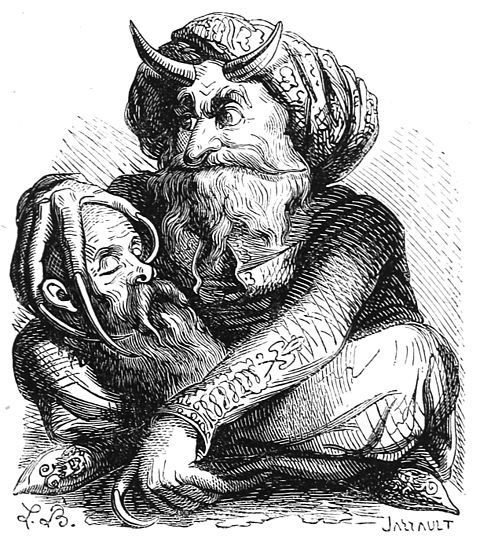
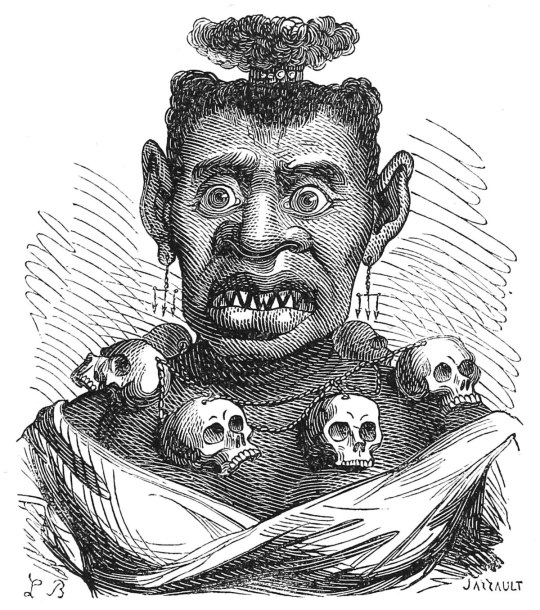
At the very least, they seem to be extremely bastardised and monstrously grotesque misrepresentations of these deities. See these more historically accurate depictions below for comparison:
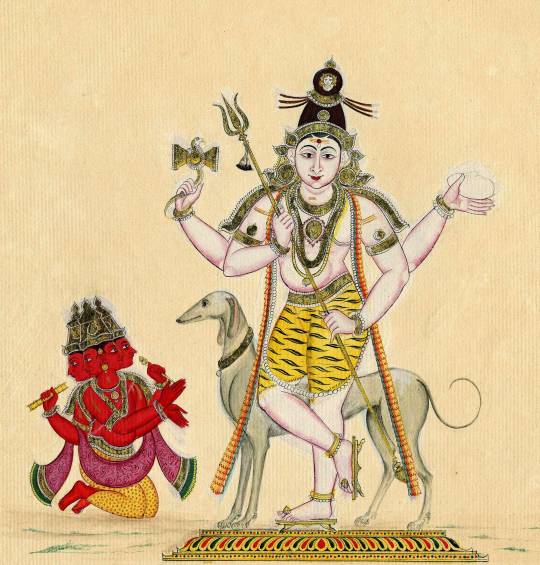
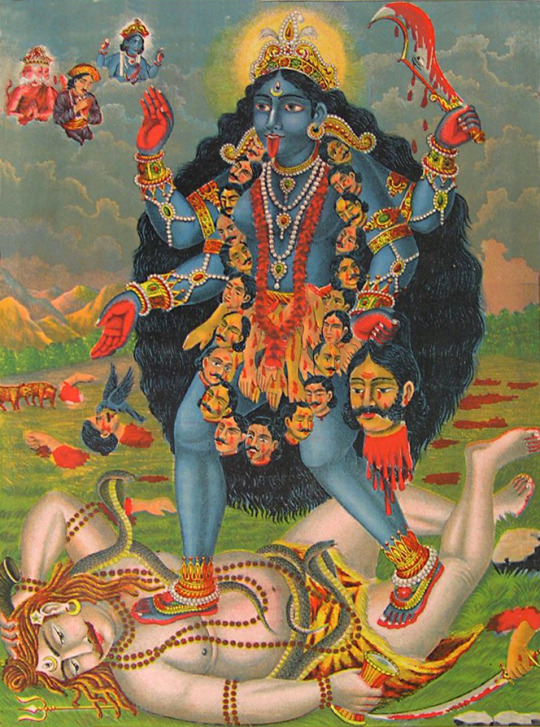
De Plancy also included entries on deities and entities such as Abraxas, Adrammelech, Alastor, Astarte, Chemosh (Chamos), Dagon, Dumuzid (Tammuz), Flaga, Guayota, Hadad (Rimmon), Milcom, Moloch, Nergal, Nibhaz (Nybbas), Nisroch, Pan, Peckols (Picollus), Pluton, Proserpina, Pucks, Rubezahl (Ribesal), Succoth-benoth, Torngarsuk, and many others that were criminally misrepresented and twisted into something they weren't.
It likely only reinforced the idea of deities such as Moloch, Chemosh, Dagan, Adrammelech, and Abraxas being considered Christianised "demons" rather than simply just deities pertaining to other religions and belief systems. Even mere underworld deities tasked with watching over the dead in the afterlife (e.g. Peckols, Pluton, Proserpina, Nergal, Dumuzid) were tainted with the stereotypical Christian idea of Hell; Fire, brimstone, pain, torment, and suffering for all of eternity.
And while some forgotten gods of dying religions might take a liking to being embraced as daemons or daemonic deities worthy of veneration in the context of Daemonolatry (as long as it's done in a respectful manner of course), these deities have still been obscenely misrepresented through the distorted perception of De Plancy's problematic views on other religions.
And that leads us into his similarly skewed views on the Daemonic Divine themselves, which isn't any better...
•──────⋆༺🕸༻⋆──────•
◦──⋆ II ⋆──◦
~ The Monstrous Misrepresentation Of Spirits ~
So not only was De Plancy a racist religiophobe (which was already rather obvious lol), but he was also quite uneducated on daemons as a whole; That is my personal opinion as both a Daemonolatrist and a Daemonologist. Having converted to Catholicism, this likely made his perception and interpretation of daemons extremely biased, because it's quite commonplace for Christianity to depict daemons in a grossly negative light.
They're basically viewed and treated like they're evil incarnate and are frequently scapegoated for most of the world's problems by religious extremists, even in the modern day. As someone who has a lot of love and respect for the Daemonic Divine, these ideas criminally misrepresent the daemons I know and love; And that goes for how they're portrayed in the Dictionnaire Infernal as well.
On top of De Plancy having a warped perception of daemons, he also seemed to have limited knowledge of the Daemonic Divine beyond their grimoire appearances; He didn't seem to have much of a UPG on them (other than the fact that he believed they were literal fallen angels who disobeyed god and were cast out of Heaven as a result), which is probably because he was biased, and didn't care to see daemons in a different perception beyond the Christian interpretation of them being the "villains".
From the thorough research I've done, it seems much more likely that daemons originate from deities pertaining to pantheons of other religions and belief systems, rather than being literal fallen angels. But that's for a whole other post in and of itself.
Aside from deities such as Baal and Astarte already being bastardised into the daemons Bael and Astaroth, as well as being depicted as such in the Dictionnaire Infernal, De Plancy himself also misinterpreted and misrepresented several deities and spirits of other folkloric backgrounds. This is very evident in his "hellish hierarchy" of spirits he considers demons included within his book. He also assigns absurdly inaccurate roles to them too. Here are just a few examples:
Kobal - This is likely a demonisation of both the Kobold sprites of Germanic mythology and the Kobaloi sprites of Greek mythology. Kobolds were commonly considered household spirits who stirred up mischief around the home. In some accounts, they were also known to do chores at night that humans neglected to finish during the day. Kobaloi were said to be impudent and mischievous spirits that were fond of tricking and frightening mortals. They were companions of Dionysus and also had the ability to shape-shift. De Plancy represented these sprites as a singular demon and assigned him with directing theatres and being somewhat of a "stage manager" in Hell.
Nybbas - This is a demonisation of a supposed deity of the Avim called Nibhaz, worshipped during the reigning of Shalmaneser I, mentioned in 2 Kings 17:31 of the Bible. Nibhaz is a rather obscure Mesopotamian deity mentioned in the Bible who was either 1) A deity whose history and mythos has been lost to time, or 2) A deity that likely never even existed in the first place. Thus, there's barely any information on Nibhaz, other than the fact that they apparently appeared in the form of a dog. De Plancy portrayed this deity as a demon under the name of Nybbas, who was in charge of managing the visions and dreams of mortals. He was said to be treated with little respect, and was regarded a "buffoon" and "charlatan".
Nergal - Here's another Mesopotamian deity that was mentioned in 2 Kings 17:31 and later demonised by De Plancy, though, Nergal seems to have a much more pronounced mythos. Nergal was a chthonic god associated with plagues, war, pestilence, death, and devastation. However, he was also said to be a benefactor to mortals; Hearing their prayers, reviving the dead, and protecting agriculture and flocks. He was equated with Irra, a god of war and scorched earth. This is probably why Nergal was later regarded as a "destroying flame" and described as "scorching". De Plancy assigned him with the role of being chief of Hell's "secret police". He is also listed as the first spy under Beelzebub's command who, in turn, is under the surveillance of "the great vigilante" Lucifer. I have absolutely no idea why Hell would even need secret police or where he even got that idea in the first place, but go figure lol. That's De Plancy for ya.
Proserpina - As far as I know, I don't think Proserpina was actually demonised prior to her appearance in the Dictionnaire Infernal. It seems that her entry within the book is the first time she was ever demonised. Proserpina is a Roman goddess (Greek equivalent: Persephone) of fertility, nature, agriculture, vegetative growth, the underworld, and the season of Spring. She is best-known for the myth of her abduction to the Underworld by the chthonic god Hades (Roman equivalent: Pluto). De Plancy includes her in his "hellish hierarchy" where he regards her as an archdiablesse (French for "archdemoness" or "arch-she-devil") and princess of evil spirits. In her grimoire entry within the Dictionnaire Infernal, she is described as being queen of the infernal empire and is associated with serpents and snakes.
Hutgin - This is another case of De Plancy demonising sprites and faeries. Hutgin is likely a demonisation of Hodekin, a kobold or sprite of Germanic folklore. Hodekin was said to be a helpful sprite and somewhat of a familiar spirit who lived with the Bishop Of Hildesheim. Hodekin was said to mainly be a nocturnal spirit and only active at night. He could see into the future and could warn one of problems to come. One of the myths surrounding Hodekin is that he was tasked with watching over the bishop's wife to make sure she remained faithful while he was away. Whenever she tried to cheat on the bishop, Hodekin would step in and assume frightening shapes, scaring the paramours away before the wife could be unfaithful. De Plancy assigns Hutgin with the role of being Hell's ambassador to the country of Turkey (for whatever reason lmao).
I don't really know how De Plancy came to such conclusions regarding daemons, deities, and other spirits; But clearly, a lot of these depictions are not very historically accurate lol. And that leads us into the next section of this post, where the depictions of the Daemonic Divine in particular weren't exactly without error in comparison to their other grimoire appearances.
•──────⋆༺🕸༻⋆──────•
◦──⋆ III ⋆──◦
~ The Inaccurate Depictions Of Daemons ~
A lot of people in occult spaces are likely familiar with Le Breton's illustrations within the Dictionnaire Infernal. However, what a lot of people don't know is that the illustrations and grimoire entries aren't very historically accurate depictions of the Daemonic Divine; That is, when you compare them to the daemons' original grimoire appearances in books such as the Livre Des Esperitz, Fasciculus Rerum Geomanticarum, Liber Officiorum Spirituum, and the Pseudomonarchia Daemonum. From the disparaging illustrated depictions to the bastardised lore, the Daemonic Divine aren't exactly documented so accurately within the Dictionnaire Infernal. Let's delve into some examples:
- - - - - - - - - -

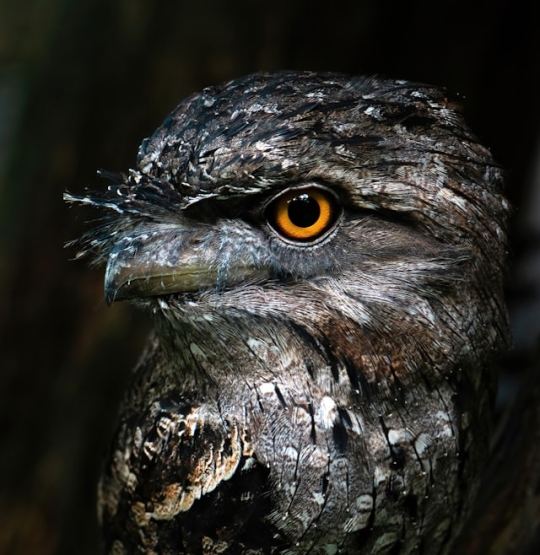
Pruflas (also called Bufas, Suffales, Bulfas, Pruslas, and Busas) is a daemon that appears in the Livre Des Esperitz, Liber Officiorum Spirituum, Pseudomonarchia Daemonum, and the Dictionnaire Infernal.
In the Dictionnaire Infernal, Pruflas is depicted as a man with the head of an owl. But for some reason, his illustration depicts Purson rather than Pruflas (Purson is described as a lion-headed man riding a bear, also being associated with trumpets). Perhaps this was either some sort of error, or De Plancy and/or Le Breton considered Pruflas and Purson to be the same daemon, even though this is not stated anywhere in the Dictionnaire Infernal.
In the Livre Des Esperitz, Pruflas's appearance is not described. In the Liber Officiorum Spirituum, he is said to appear as a spark of fire. In the Pseudomonarchia Daemonum, he is said to appear with the body of a fiery flame and the head of a nighthawk or nightjar (described as "nycticoraci" in the original Latin version).
The term "nycticoraci" or "nycticorax" is translated to "night raven" in English. This term likely originates from Leviticus 11:16 of the Bible, which regards the "night raven" as any bird of ill omen. The specific birds regarded as night ravens mentioned in Leviticus 11 are; Eagles, vultures, black vultures, red kites, black kites, ravens, horned owls, screech owls, gulls, hawks, little owls, cormorants, great owls, white owls, desert owls, ospreys, storks, herons, hoopoes, and bats (even though bats aren't birds lol).
Later, the term "nycticorax" was used to name a specific genus of night herons. It was specifically also used to refer to the best known species, the black-crowned night heron. Given that the term "night raven" can refer to any bird of ill omen in Christianity, this may explain why daemons such as Stolas, Andras, and Aamon are depicted as either being owl-headed or taking on the appearance of an owl.
- - - - - - - - - -
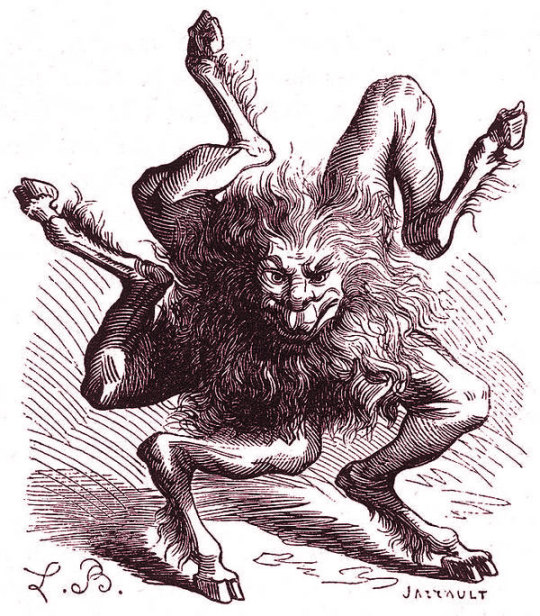

Buer (also called Gemer) is a daemon that appears in the Livre Des Esperitz, Pseudomonarchia Daemonum, Ars Goetia, and the Dictionnaire Infernal.
In the Dictionnaire Infernal, Buer is depicted as appearing in the form of a star or five-pointed wheel. Le Breton's illustration depicts him as a disembodied lion's head with five goat legs, giving him the ability to "walk" or roll in all directions. This is a historically inaccurate depiction of how Buer appears, because he isn't depicted as a quintuple-goat-legged lion head in any of his grimoire appearances whatsoever.
In the Livre Des Esperitz, Buer's appearance is not described. In the Pseudomonarchia Daemonum, he is said to appear in the form of a star. In the Ars Goetia, he is said to appear in the form of a "sagittary" or centaur, specifically when the Sun is in Sagittarius.
Buer is likely a demonisation of Chiron, a superlative centaur from Greek mythology who specialised in healing, medicine, and astrology; Which explains Buer's similar functions and the account of him appearing in the form of a "sagittary" in the Ars Goetia.
- - - - - - - - - -
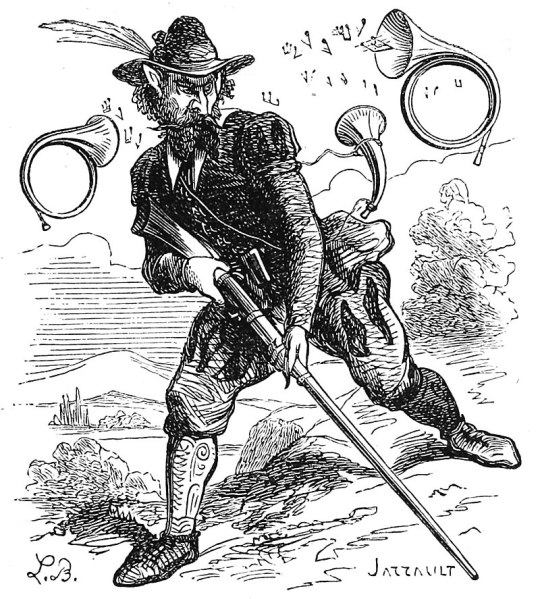
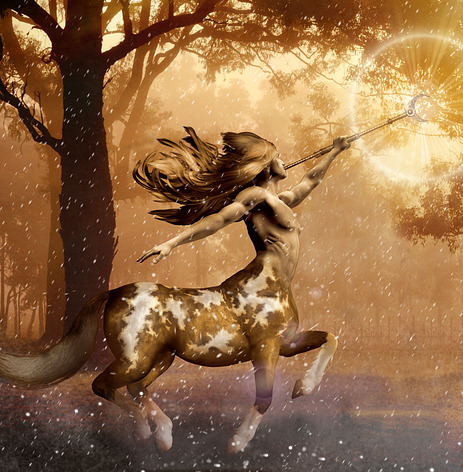
Barbatos (also called Barbates, Barbares, Barbais, Barbas, and Barbarus) is a daemon that appears in the Livre Des Esperitz, Munich Manual Of Demonic Magic, Liber Officiorum Spirituum, Pseudomonarchia Daemonum, Ars Goetia, and the Dictionnaire Infernal.
In his Dictionnaire Infernal illustration, Barbatos is depicted as a bearded hunter wielding a hunting rifle, and he is said to inhabit the forests. In his grimoire entry, he is alternatively said to appear as an archer. He is also compared to Robin Of The Woods (a.k.a. Robin Hood) and Jack In The Green.
In the Livre Des Esperitz, Barbatos's appearance is not described. In the Munich Manual Of Demonic Magic, he is said to appear as a forest archer who is accompanied by four kings carrying trumpets. In the Liber Officiorum Spirituum, he is said to appear in the form of a shouter, forest man, or wild archer. Alternatively, he is also said to appear as a centaur or "sagittary" that is described as being "half-man and half-beast". In the Pseudomonarchia Daemonum, he is said to appear in the form of a woodland archer. In the Ars Goetia, he is said to appear in the form of a "sagittary" or centaur, specifically when the Sun is in Sagittarius; Similarly to Buer.
While his form described in the Ars Goetia is said to be a mistranslation, it's not technically an inaccurate depiction. He appears as a centaur in the Liber Officiorum Spirituum, after all. His depiction as a forest man isn't too inaccurate either, given that Barbatos is possibly tied to the mythical figure Woodwose originating in medieval Europe, and functions similarly.
- - - - - - - - - -
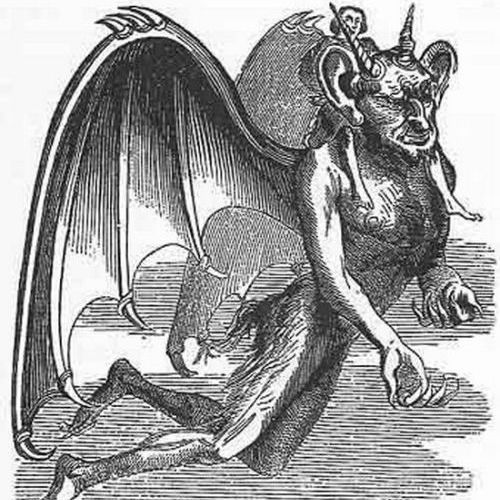
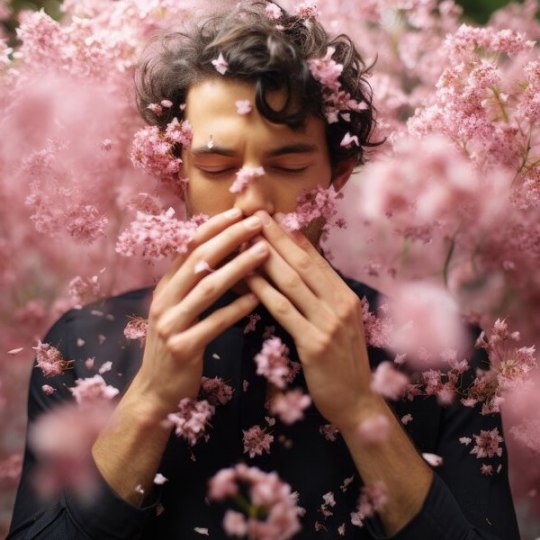
Gaap (also called Tap, Goap, Coap, Taob, Ducay, and Balath) is a daemon that appears in the Livre Des Esperitz, Munich Manual Of Demonic Magic, Liber Officiorum Spirituum, Pseudomonarchia Daemonum, Ars Goetia, and the Dictionnaire Infernal.
In the Dictionnaire Infernal, Gaap is said to appear at noon in human form. But in his illustration, he is depicted as a devil-like figure, or more plausibly, as a man riding upon the shoulders of a devil-like figure. Many people have interpreted this illustration as the demon figure being Gaap himself. But given his Dictionnaire Infernal entry, it's probably more likely that Gaap is the human mounted on the shoulders of the demon-like figure.
In the Livre Des Esperitz, Gaap's appearance is said to appear "very benignly". In the Munich Manual Of Demonic Magic, he is said to appear as a healer that assumes human form, and is also regarded as a doctor. In the Liber Officiorum Spirituum, he is said to appear as a misshapen image. In the Pseudomonarchia Daemonum, he is said to appear in a "meridional sign". In the Ars Goetia, he is said to appear in human form when the Sun is in the Southern signs.
As previously stated, it's likely that many people have interpreted Gaap's illustration as him being depicted as the devil-like figure, instead of the man that is mounted on him. Looking at his other grimoire appearances, it's likely that the illustration was meant to depict Gaap as taking the form of a human mounted on the shoulders of a devil-like being.
- - - - - - - - - -
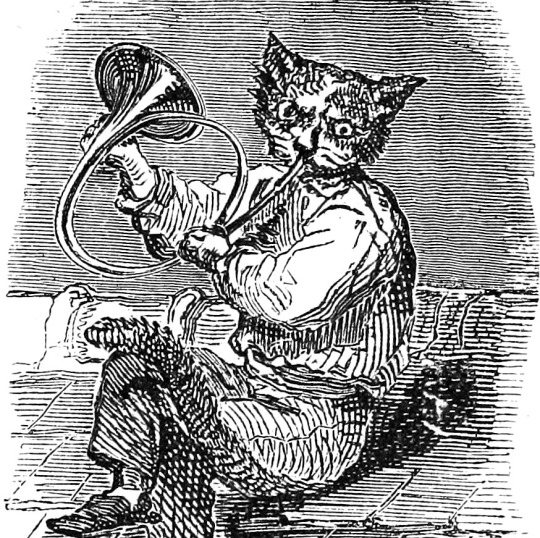

Beleth (also called Bileth, Bilet, and Byleth) is a daemon that appears in the Liber Officiorum Spirituum, Pseudomonarchia Daemonum, Ars Goetia, and the Dictionnaire Infernal.
In the Dictionnaire Infernal, she is said to appear as a "terrible" king riding a white horse, preceded by cats blowing horns and trumpets. However, her illustration seems to depict her as cat-headed person playing a horn, surrounded by dancing mice. Perhaps this illustration was meant to depict one of the horn-blowing cats that precede Beleth? I'm not sure.
In the Liber Officiorum Spirituum, Beleth's appearance is not described. In the Pseudomonarchia Daemonum, she is said to appear furiously, riding upon a pale horse; The sounding of trumpets and the playing of all sorts of other musical instruments are heard before her. In the Ars Goetia, she appears pretty much in the same way as described within the Pseudomonarchia Daemonum.
It's also just my personal UPG that Beleth is a girl lol, as I believe she likely originated from the Mesopotamian goddess Belet-ili. As far as I know, I don't think Beleth is depicted as a woman in any of her grimoire appearances. Her Dictionnaire Infernal entry and illustration don't seem to align either, so it's likely that the trumpet-blowing cat drawing was meant to depict the cats that precede Beleth, rather than Beleth herself.
- - - - - - - - - -
These are just a handful of the inaccurate depictions of the Daemonic Divine and other spirits within the Dictionnaire Infernal. If I were to delve into all of them in great detail, this post would be far too long... So I'm gonna end it there lol.
•──────⋆༺🕸༻⋆──────•
In conclusion, I personally don't advise going to the Dictionnaire Infernal as your sole source of research on daemons; Especially if you're a daemonolatrist. I'd instead recommend looking at their other grimoire appearances, especially the earlier ones. The grimoires I recommend looking into are:
Livre Des Esperitz
Fasciculus Rerum Geomanticarum
Liber Officiorum Spirituum
Pseudomonarchia Daemonum
Ars Goetia
I hope you find this post helpful! And as always, I wish you well on your spiritual path. Also, a big thanks to my friend @sortiarus-de--naturas--daemonum for helping me out with this post! I could not have written this without her. 💜
•──────⋆༺🕸༻⋆──────•
❀༻ Ave Satanas ༺❀

+. Image Sources .+ ... Nightjar Photo ... Centaur Image V1 ... Centaur Image V2 ... Flower Petals Image ... Horse Rider Image ...
#daemonolatry info posts#demonolatry#demonology#demons#dictionnaire infernal#daemonic divine#paganism#daemonolatry#daemonology#pagan#daemons#witchblr#paganblr#daemonblr#infernal dictionary#demonolatry resources
29 notes
·
View notes
Text

The nocturnal demon that wanders the countryside, his appearance is that of a wild man or troll.
Interestingly, his candle-holding hand has been compared to the Hand of Glory legend.
#BriefBestiary#bestiary#digital art#fantasy#folklore#legend#myth#mythology#yan-gant-y-tan#demon#breton folklore#breton legend#demon folklore#nocturnal demon#night demon
13 notes
·
View notes
Text





Welsh!Night Court + Welsh Mythology
Cŵn Annwn: spectral hounds of Annwn, the otherworld of Welsh myth, associated with Arawn or Gwyn ap Nudd in the Wild Hunt
Morgens: Welsh + Breton water spirits that drown men. Has been compared to sirens/mermaids without fishtails. The mari-morgans, who were well-versed in evil spells, would drag young men underwater and the men would never be seen again
Cyhyraeth: ghostly spirit in Welsh mythology, a disembodied moaning voice that sounds before a person's death; similar to the Iriah Banshee. The noise is said to be "doleful and disagreeable", like the groans and sighs of someone deathly ill, and to sound three times (growing weaker and fainter each time) as a threefold warning before the person expires
Ceffyl Dŵr: a water horse in Welsh Mythology, similar to the Kelpie or Púca. They inhabit mostly mountain pools, waterfalls or seashores. Believed to be a spirit assuming the shape of a black or gret horse w a white mane. It will carry its rider a great distance or fly into the sky, evaporate into mist and then drop the rider to their death
The Wild Hunt: Gwyn ap Nudd was depicted as a wild huntsman riding a demon horse who hunts souls at night along with a pack of white-bodied and red-eared 'dogs of hell'. In Arthurian legends, he is the king of the Underworld who makes sure that the imprisoned devils do not destroy human souls
🤌🏻🤌🏻🤌🏻 the POTENTIAL. the IMAGE of such a beautiful and colorful (and spooky) mythology that could be brought to life in the night court. with SJM going for a "Haides and Persephone" retelling, it'd be so interesting to see various forms of creatures or fae that are related to death or death omens or are just extremely dangerous that can, u know, cause death lmao
15 notes
·
View notes